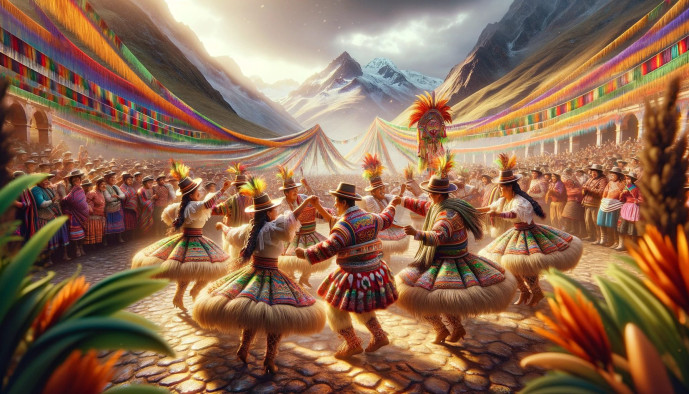Music a Dances in Bolivia
Explore Bolivia's vibrant culture through its traditional music and dance forms.

Historical Context
In the colorful tapestry of Bolivian culture, music and dance threads are woven from both indigenous roots and Spanish colonial influence. These art forms are more than just entertainment; they’re a resilient force of cultural preservation. Through times of conquest and change, Bolivia’s rhythmic heartbeat has kept its history alive and kicking—quite literally.
Traditional Bolivian Music
Bolivian folk music is as diverse as the country’s landscapes, with flutes, drums, and stringed instruments crafting the soundtrack of the Andes. Charango, a small lute-like instrxument, and quena, a wooden flute, are uniquely Bolivian and central to the music scene. Regional styles vary from the melancholic tones of the Altiplano to the tropically infused rhythms of the Oriente.
Popular Bolivian Dances
Carnaval de Oruro
At the heart of Bolivia’s dance diversity is the Carnaval de Oruro, a UNESCO-worthy spectacle. Here, the diablada takes center stage, showcasing dancers in devilish masks engaged in an epic battle between good and evil. It’s not just a dance but a storytelling marathon on steroids.
Morenada
Morenada, with its roots in the history of African slavery in Bolivia, is both a critique and a celebration. Dancers don elaborate costumes with masks depicting sad faces, a nod to the suffering of slaves, and perform with a distinctive, ponderous gait that’ll have you captivated from the get-go.
Caporales
Caporales is a dance that screams machismo with a side of elegance. Stemming from the Afro-Bolivian Saya, it tells the story of the overseer of slaves, or caporal, with dancers embodying the swagger and authority with each stomp and twirl.
Tinku
The Tinku dance is more than just fancy footwork; it’s a ritual that has bloodied knuckles to match the beats. Originating from a form of ritualistic combat among indigenous communities, it’s now often watered down for tourists—less blood, but still a sight to behold.
Saya Afroboliviana
Don’t let the Saya Afroboliviana pass you by; this is the dance that’ll make your hips lie. With its roots in African rhythms, the Saya is a cultural treasure and a symbol of the Afro-Bolivian community’s struggle and joy.
Chacarera Boliviana
Now, Chacarera Boliviana might sound like its Argentine cousin, but it’s got its own Bolivian twist. Faster and with a more syncopated rhythm, this dance will have you questioning your coordination skills.
Modern Music and Dance Scene
Contemporary genres like rock, pop, and reggaeton have muscled into the Bolivian scene, but don’t think for a minute that traditional beats have taken a back seat. Fusion bands are mixing up the old with the new, creating a soundtrack for Bolivia that’s as dynamic as its people.
Festivals and Celebrations
If Bolivia’s social calendar had a status, it would be “it’s complicated.” With an endless roster of festivities, music and dance aren’t mere performances; they are the soul of the party. From the Gran Poder in La Paz to the Pujllay in Tarabuco, there’s a fiesta for every day of the year—if you’ve got the stamina.
Preservation and Education
Bolivia doesn’t just rely on the power of memories; it’s got music and dance schools working overtime to keep traditions on the tips of everyone’s tongues and toes. These institutions are the unsung heroes, ensuring the next generation can two-step into the future without missing a beat.